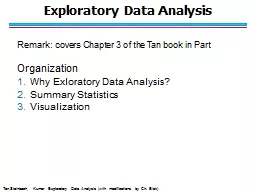PPT-Exploratory Data Analysis
Author : liane-varnes | Published Date : 2016-05-05
John Tukey Developed these procedures to help one get a first look at distributions of scores What is the shape of the distribution Are there any suspicious scores
Presentation Embed Code
Download Presentation
Download Presentation The PPT/PDF document "Exploratory Data Analysis" is the property of its rightful owner. Permission is granted to download and print the materials on this website for personal, non-commercial use only, and to display it on your personal computer provided you do not modify the materials and that you retain all copyright notices contained in the materials. By downloading content from our website, you accept the terms of this agreement.
Exploratory Data Analysis: Transcript
Download Rules Of Document
"Exploratory Data Analysis"The content belongs to its owner. You may download and print it for personal use, without modification, and keep all copyright notices. By downloading, you agree to these terms.
Related Documents














